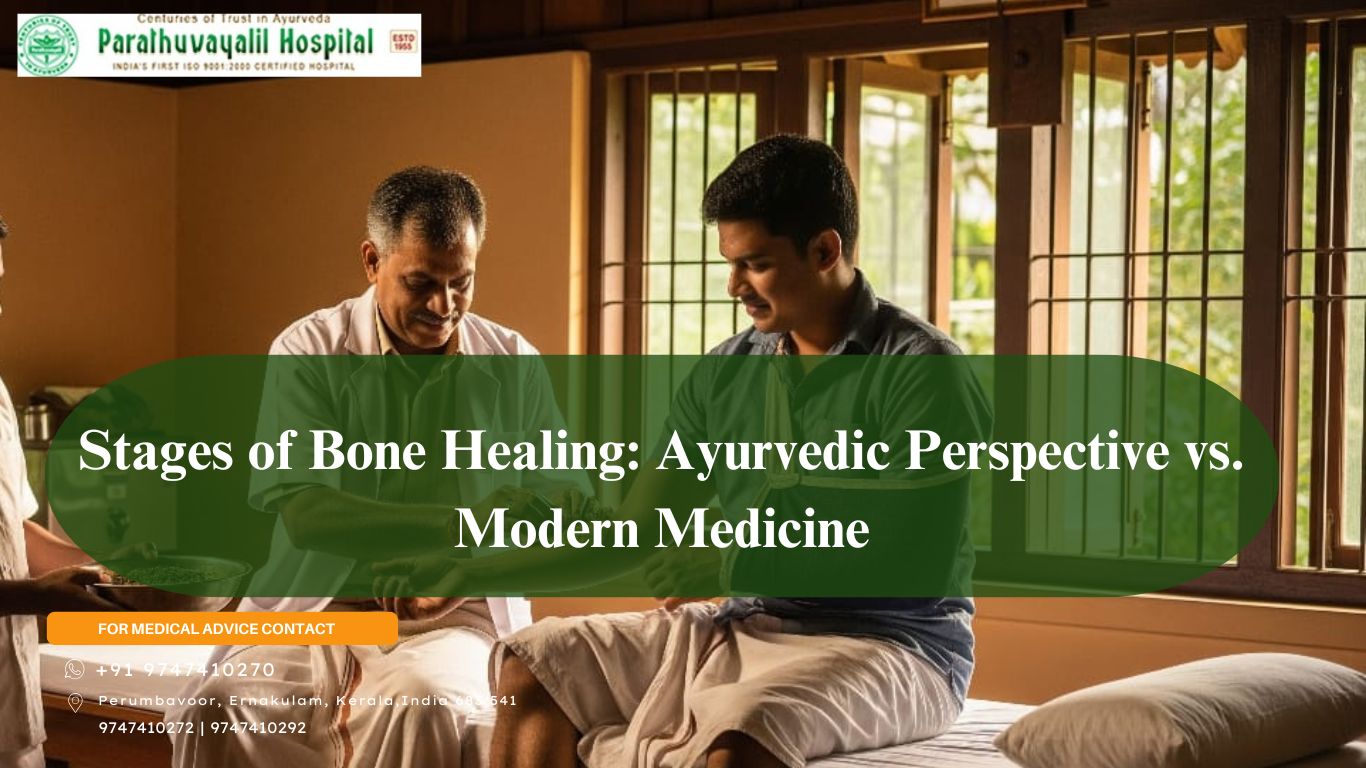
Stages of Bone Healing: Ayurvedic Perspective vs. Modern Medicine

Bone fractures are among the most common injuries affecting people of all age groups. While bones are naturally designed to heal themselves, the process is gradual and requires proper care. Fracture healing in three major phases— inflammation, repair, and remodeling—with each stage playing a vital role in restoring normal bone strength and structure.
Ayurvedic traditional describes it as Bhagna Chikitsa (treatment of fractures explains the healing process through the lens of doshas (Vata, Pitta, Kapha) and dhatus (tissues) and also prescribes time-tested interventions using herbs, oils, therapies, and diet to accelerate bone recovery and prevent complications.
At Parathuvayalil Ayurveda Hospital, which has earned wide recognition for fracture care and traditional treatments since 1955,with modern diagnostic techniques. This unique combination provides patients with a safe, effective, and holistic path to recovery.
Understanding Stages of Bone Healing in Modern Medicine
Modern (allopathic) medicine explains bone healing as a biological cascade involving cellular and biochemical events. The process typically unfolds in three overlapping but distinct phases:
Stages of Fracture healing
In stage one – there is inflammation and haematoma formation at the fracture site – which acts like a scaphold. At this stage fracture is unstable and needs splinting and bandage with soft cotton material wrapped on the injury site. Wounds need to be taken care of.
In stage two there is soft callus formation which acts like a glue sticking the fracture ends. The period extends around 3 to 4 weeks, over which the callus matures and hardens giving more stability. X-rays at this stage show external visible callus. Beyond this stage fracture manipulation is not advised.
At around 6 weeks of time the external callus hardens enough to form a bridge & wrap around the fracture to give it good stability. During this stage 3 active movements at the adjacent joints to fracture site is encouraged as tolerated.
Other external support will be continued depending on the site of fracture.Bone remodelling occurs in stage 4 and it consolidates at around 6 months to 1 year. The patient will be functionally fit by the end of 12 weeks.
Bone Healing As unserstood in Tradition Bhagna Chikitsa
Ayurveda recognizes fractures under the branch of Asthi Chikitsa (orthopedics) and more specifically, Bhagna Chikitsa. The ancient texts Sushruta Samhita and Charaka Samhita describe in detail the causes, types, and treatments for fractures.
Ayurveda views fracture healing as a process involving the balance and nourishment of doshas (Vata, Pitta, Kapha) and dhatus (especially Asthi dhatu – bone tissue). The three modern phases of bone healing can be mapped to Ayurvedic understanding as follows:
1. Inflammatory Phase → Vata & Pitta Predominance
The initial trauma disturbs Vata dosha, which governs movement and pain. The rupture of vessels and heat generation correspond to Pitta dosha, responsible for inflammation and metabolic changes. The hematoma resembles the accumulation of rakta dhatu (blood tissue) at the fracture site.
- Immobilization (Bandhana): Traditional splints Soft cotton and bandages stabilize the fracture (similar to p;aster casting).
- Snehana (oleation): Use of medicated oils to pacify aggravated Vata.
- Lepa (herbal pastes): Application of herbal pastes like Dashanga lepa to reduce swelling and pain.
- Diet: Warm, easily digestible foods with anti-inflammatory herbs like turmeric and ginger.
2. Reparative Phase → Kapha & Pitta Support
As healing progresses, Kapha dosha (responsible for structure, stability, and lubrication) supports the formation of new tissue (soft callus).
Pitta dosha helps in metabolic transformations, enabling immature tissue to mature into bone.
- Basti (medicated enema): Nourishes asthi dhatu from within by balancing Vata.
- Snehana (oleation): Use of medicated oils to pacify aggravated Vata.
- o Herbal formulations:
Laksha Guggulu – enhances bone union.
Asthisamharaka (Cissus quadrangularis) – traditionally known as “bone setter’s herb.” Commonly used in modern pharmacology
Shallaki (Boswellia serrata) – anti-inflammatory and bone strengthening. - Taila abhyanga (oil massage): Improves circulation and tissue repair.
- Diet: Calcium-rich foods like sesame seeds, milk, ghee, and green leafy vegetables.
3. Remodeling Phase → Vata Stabilization & Dhatu Poshana
The remodeling stage corresponds to the long-term nourishment of Asthi dhatu and stabilization of Vata. Ayurveda emphasizes rejuvenation (Rasayana Chikitsa) to ensure that bones regain full strength and durability.
- Rasayana herbs: Ashwagandha, Shatavari, and Guduchi for systemic rejuvenation.
- Abhyanga (oil therapy):Long-term strengthening of muscles and bones.
- Yoga & mild physiotherapy:
Controlled movements to restore flexibility and alignment. - Diet:Bone-nourishing foods, avoiding Vata-aggravating items like excessive dry, cold, or spicy food.
Ayurvedic vs. Modern Approach – A Comparative View
| Healing Phase | Orthopedic Treatment | Ayurveda (Bhagna Chikitsa) |
|---|---|---|
| Inflammation (0–7 days) | Fracture hematoma, immune response, inflammation | Vata–Pitta imbalance, Rakta dhatu disturbance; Bandhana, lepa, snehana |
| Repair (1–6 weeks) | Callus formation (soft → hard), osteoblast activity | Kapha–Pitta support, tissue building; Laksha Guggulu, Asthisamharaka, basti |
| Remodeling (months–years) | Woven bone reshaped to lamellar bone | Vata stabilization, Asthi dhatu nourishment; Rasayana chikitsa, yoga |
Integrated Management
Bone healing is a remarkable natural process While modern science explains the cellular and structural changes in detail, Ayurveda see through a prism of doshes(physiological balance)
By integrating the two perspectives, patients can experience faster recovery, reduced complications, and long-term bone strength especially in children’s & adolescences
At Parathuvayalil Ayurveda Hospital, this philosophy has guided treatment for over six decades, making it a trusted name in fracture management and orthopedic care worldwide.






